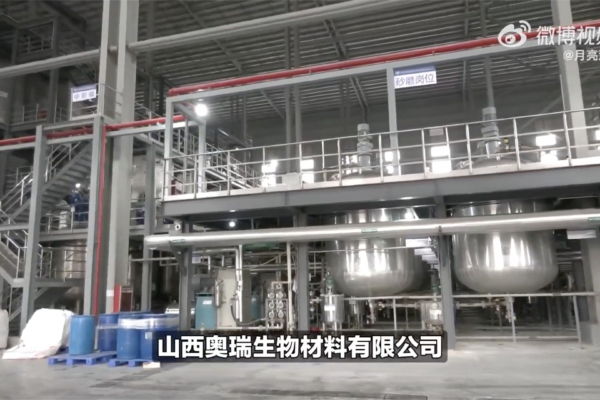The “Sale of Thousands of Corpses” case recently exposed has stirred up public opinion in China. According to the materials, the involved entities include state-owned tertiary hospitals, crematoriums, funeral homes, as well as the relationship between a core enterprise under China National Pharmaceutical Group and the implicated companies. Additionally, the organization behind the illegal activities was revealed to be a subsidiary of a central state-owned enterprise, and the background of the actual person in charge of that company has also been exposed.
On August 8th, Chinese lawyer Yi Shenghua publicly released materials related to a case involving theft, insult, and intentional destruction of corpses online. The materials allege that Shanxi Aorui Bio-material Co., Ltd. (referred to as “Shanxi Aorui Company”) is suspected of illegally procuring corpses and limbs as raw materials for producing “homologous bone implant materials” products, with a total operating income reaching 380 million yuan from 2015 to 2023. During the investigation of the case, the police seized more than 18 tons of human bone raw materials and semi-finished products, as well as 34,077 finished products.
According to the materials, this case involves illegal theft and trafficking of over 4,000 corpses.
The materials show that a total of 75 criminal suspects are involved in the case, including entities such as Shanxi Aorui Company, Sichuan Hengpu Company, Shandong Qingdao University Affiliated Hospital Liver Disease Center, Guilin Medical College, Guilin City Funeral Home, Pingle County Funeral Home, Yongfu County Funeral Home, and others. Furthermore, it also involves the suspect Su controlled Yunnan Shuifu City Crematorium, Chongqing Banan District Crematorium, Guizhou Shiqian County Crematorium, Sichuan Daying County Crematorium.
The materials issued by the Taiyuan Public Security Bureau on May 23 of this year indicate that the case has been transferred to the Taiyuan Prosecutor’s Office for review and prosecution. However, after lawyer Yi Shenghua made the materials of the case public, the authorities started to crackdown on mainland Chinese media and social platforms.
Entities implicated in the sale of thousands of corpses case go beyond state-owned tertiary hospitals, crematoriums, funeral homes. Reports from The Paper and Jiemian News exposed the relationship between Shanxi Aorui Company and China National Pharmaceutical Group. According to reports, in the result announcement of the registration of consumables at China National Pharmaceutical Group Quanzhou Co., Ltd., Shanxi Aorui Company appeared as a producer of homologous bone implant materials for the company, with multiple specifications of products mentioned in the result. Additionally, the company has been mentioned in multiple bid announcements.
On August 9, China National Pharmaceutical Group released a statement claiming that there is no business dealings or any relationship with Shanxi Aorui Bio-material Co., Ltd. as reported in the media. The subjects involved in the relevant media reports are not related to China National Pharmaceutical Group.
China National Pharmaceutical Group, officially known as China National Pharmaceutical Group Co., Ltd., is a core enterprise under China National Pharmaceutical Group and is a state-owned enterprise of the Communist Party. China National Pharmaceutical Group currently owns and operates China’s largest drug distribution and supply network, covering 29 provincial-level administrative regions, providing comprehensive distribution, logistics, and value-added services to customers and suppliers.
It is noteworthy that the implicated Shanxi Aorui Company is a subsidiary of the China Institute of Radiation Protection. The official website of the China Institute of Radiation Protection shows that the institute is a subsidiary of the Central Enterprise China National Nuclear Corporation. The China National Nuclear Corporation ranks first on the list of central enterprises under the State-owned Assets Supervision and Administration Commission of the State Council.
According to Sina Finance, Shanxi Aorui Company is not only a high-tech enterprise but also a specialized and innovative enterprise. The actual person in charge of Shanxi Aorui Company is Li Baoxing.
Materials show that Li Baoxing, male, born in January 1955, is a researcher specializing in human anatomy and embryology, a doctoral supervisor, and originally worked at the China Institute of Radiation Protection’s Institute of Biological Material Pharmaceutical Technology. In 1987, Li Baoxing graduated from a university in Suzhou with a degree in Radiology and Public Health and was assigned to work in the Institute of Nuclear Medicine Research at the China Institute of Radiation Protection. In July 1998, Li Baoxing was appointed as the Deputy Director of the Institute of Life Sciences, also serving as the Director of the Shanxi Province Medical Tissue Repository.
An article published in December 2005 titled “Remembering Li Baoxing, National Model Worker, Shanxi Defense Industry Pride” revealed that Li Baoxing, under his leadership, developed independently patented “homologous bone implant materials” products. The article also mentioned that the Shanxi Medical Tissue Repository established Shanxi Aorui Bio-material Co., Ltd., with Li Baoxing as the general manager. With his planning and operation, the company’s technology and processes were leading in the industry globally, with an 80% market share, making it the largest homologous bone material production base in the Asia-Pacific region. The Shanxi Medical Tissue Repository also became the largest medical tissue repository in the Asia-Pacific region.
The exposure of the “Sale of Thousands of Corpses” case has sparked wide attention and scrutiny from the public.
An article published on ifeng.com titled “Selling Thousands of Deceased Body Cases, Why Hasn’t Such a Large Case Been Exposed for Many Years?” questions why, despite the existence of a limited number of identifiable crematoriums and medical institutions, the civil affairs departments and other regulatory enforcement agencies did not detect traces of such operations over such a long period. This raises doubts.
The article questions why, over such a long period, the concentrated processing of those defined as illegally stealing and selling deceased body parts, with such high frequencies and large quantities, went unnoticed. It also raises suspicions about how the company and its partners in the supply chain managed to falsify numerous donation certificates, acquire such a large and high-quality supply of homologous bone material without raising reasonable suspicion. Where did this company find such a large quantity of high-quality homologous bone material?

